
 |
 |
 |
 |
 |
 |
 |
MTB world championships - CM
Rotorua, New Zealand, August 22-27, 2006
Dial MTB for Maori culture
by Mikkeli Godfree
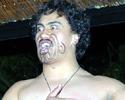
|
If the UCI World Championships presently taking place in the city of Mozart is the Salzburg Symphony of cycling, it would be a mistake to consider last month's MTB Worlds as the Rotorua Rampage.
While the knobby-tired persuasion of bicyclists are often viewed as the ones who 'leave the biggest mark' on the earth, and with the city of Rotorua in New Zealand's north island famed for its boiling, sulphur hot springs, the race organisation ensured that the focus of this event would be the environment and local Maori culture, itself deeply rooted in the city and its surrounds. It was this aspect that made this year's World Championships a special event.
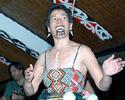
|
At more obvious end of the spectrum was the Te Maori Arts Village, situated at the entrance to the race village which filtered spectators, competitors and media alike as if through duty free at the airport. At the other, more subtle end were things like the downhill course whose design was heavily influenced by Maori culture. The downhill start was lined with Palisades - a fence made of sharp sticks to protect the Marae, a Maori meeting place or village.
The interesting thing about the Palisades was looking past them from the start, where they framed Mokoia Island in the centre of Lake Rotorua. This island is very important to the Maori in the area, for it was a focal point for much Maori history. I'm not sure if riders like Chris Kovarik were able to appreciate this as they dialled the course on race day but at least Chris, as the fastest rider down the mountain for some time, was able to sit in a huge Maori-carved hot seat and see if he would become World Champion. Although he was in good hands, Sam Hill ended up sitting most comfortably in this hot seat, as I'm sure you are now probably aware.

|
The island and the mountain, Mt Ngongotaha, on which the World Championships were run, were formed 100,000 years ago by volcanic activity. As a result, being in Rotorua is like living (momentarily for us) on or in a volcano. The stench of sulphur is often enough to make you feel ill, and the steam pouring out of vents on the road and across it from thermal baths are enough to remind you of the serious activity below.
While seeing a few things on course and maybe a little steam around town were one thing, the race organisers made an exceptional effort to bring the Maori culture to the attention of the mountain-biking public. In fact, this is not unique to the World Championships, since 1987, the New Zealand government has made a concerted effort to revitalise Maori culture and integrate it into modern society and the tourist industry. The result is that visitors to New Zealand, non-indigenous New Zealanders and Maori's themselves can access Maori history and gain an appreciation for the rich, powerful and enchanting culture.
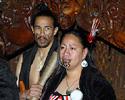
|
The attempt to revitalise Maori culture and bring it into the mainstream was made all the more easy by the fact that the Maori population has remained relatively strong and has actually been growing (21% between 1991-2001). One in seven people in New Zealand are Maori, 90% of whom live on the north island and 25% of whom speak the Maori language.
The race organisers here in Rotorua were very keen to get the media involved in the Maori history of the area and of New Zealand generally. In our media packs we were given bone carvings and then, on the Monday before the event, we were whisked away to Tamaki village run by Doug Tamaki. There we were talked through the experience by Doug who employs 130 predominantly Maori people.
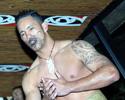
|
Doug invited us into his Marae (meeting place) which is central to the concept of Maoritanga (Maori culture). There, we the manihiri (visitors) were welcomed by the whenua (hosts) by an inoi (prayer) which would ensure the safety of both parties. The welcome also included a haka powhiri (welcome dance) - thankfully the welcoming kind of haka and not the hostile one as seen before hostile rugby matches. You could have fooled us, though, because it was terrifying! We were then given a tour of an outdoor village that was so authentic that we felt we had gone back in time to witness traditional games, dances and songs.
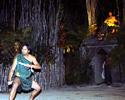
|
The song and dance was not so much entertainment as a window into the way the traditional Maori used to live. It was very powerful and was a stirring prelude to the final stage of the powhiri (the formal Maori welcome) - the feast or Hakari. Aside from the racing, this was a true highlight of our visit to New Zealand and although I have travelled here before, this time was far more special.
I'll leave you with a version of the translated haka, so next time you hear it you won't be so scared, and you can gain one of the millions of insights into Maori culture that are here to be discovered.
Come see for yourself!
Ka mate! Ka mate! Ka ora! Ka ora!
(I die! I die! I live! I live!)
Ka mate! Ka mate! Ka ora! Ka ora!
(I die! I die! I live! I live!)
Tenei te tangata puhuruhuru
(This is the hairy person)
Nana nei I tiki mai whakawhiti te ra
(Who caused the sun to shine again)
A hapane! A kaupane!
(One step up! Another step up!)
A hapane! A kaupane!
(One step up! Another step up!)
Whiti te ra! Hi!
(The sun shines!)
For a thumbnail gallery of these images, click here
Images by Mikkeli Godfree/Cyclingnews.com
- The haka powhiri up close.
- The Maori of Rotorua are proud of their culture.
- The 'whenua' (hosts) welcome the manihiri (visitors).
- The 'whenua' performing the 'powhiri', the formal Maori welcome.
- A pleasant time is guaranteed for all.
- This is the scary person who caused the sun to shine again.
- The inoi (prayer) is performed to ensure the safety of all.
- Maori performing the haka powhiri (it's OK, no rucks and mauls here!)
- Suited up and ready to go.
- Tamaki village is stunning by night.